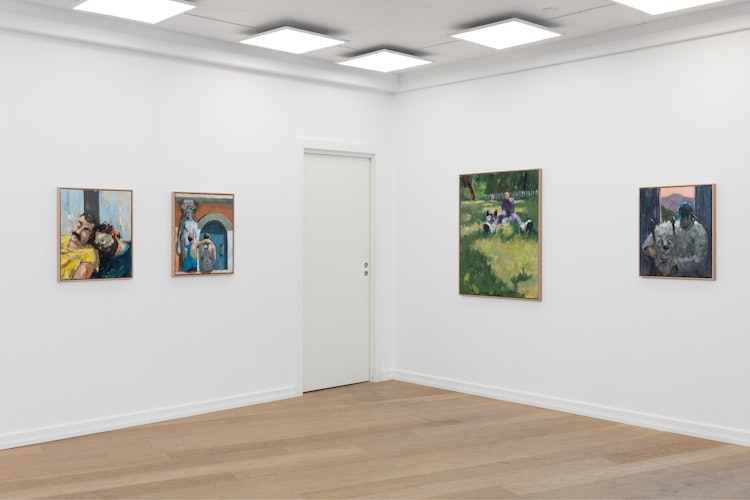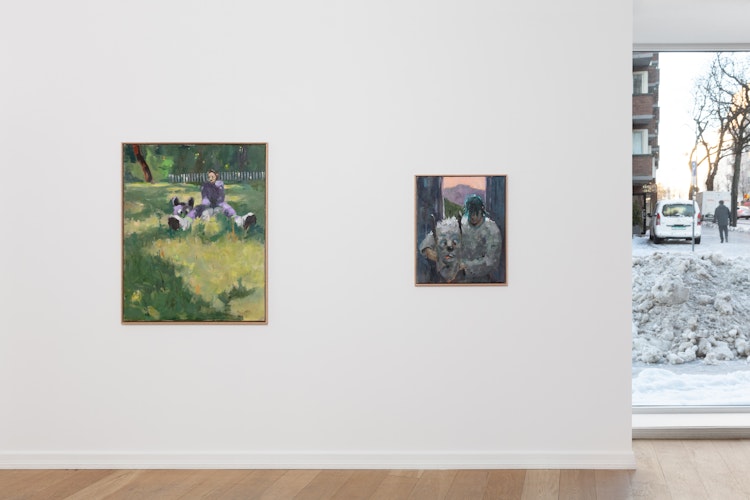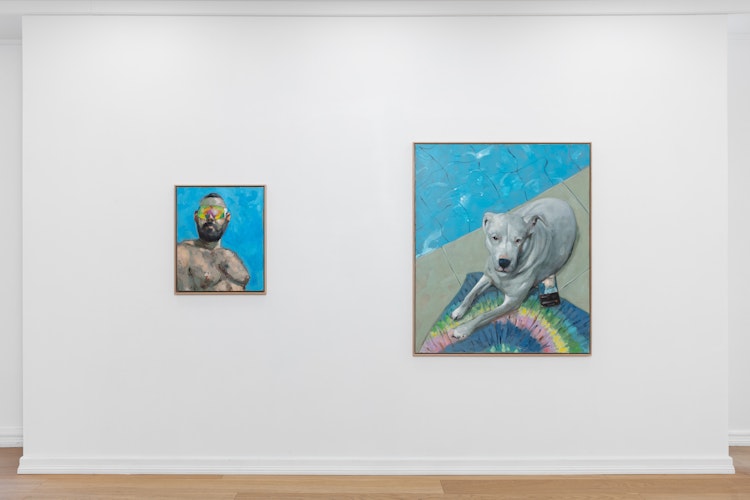Looking for trouble


In painter Endre Aalrust’s canvas Awe (2024), two gym queens sit with their backs toward the viewer on a balustrade. Both men sport racerback tank tops that reveal their bulging dorsal and arm muscles. One man casually drapes his bare arm around the other’s shoulders in a gesture of possessive affection. Both men sit gazing at a closed blue door with a prominent handle; the space on the balcony is somewhat claustrophobic and the men are perched uncomfortably close to a supportive caryatid, i.e. a column in the shape of a woman. She, in turn, appears to be aghast at what she is seeing. Her eyes stare out blankly at the viewer, her mouth agape with horror. Since we can only see the men’s backs, we cannot be sure what has startled or disturbed her. Is it the closeness of intimacy? Is there something – perhaps something obscene – to which the viewer is not privy?
This play with interrupted and displaced points of view is a consistent element of all of the paintings in Aalrust’s first solo show with QB Gallery. In Critical Reflection, a pair of mirrored sunglasses obstruct the viewer’s access to the eyes (and hence, interiority) of a bear-like man who gazes out of the canvas, leaving us only with a recalcitrant albeit brightly-colored surface. In Masc, two men snuggle but are fundamentally disconnected from one another in spite of their physical proximity; one has his eyes closed, while the other wears a sleep-mask which is absurdly decorated with two wide-open googly eyes. In several paintings, young men in furry costumes remove their masks. Yet because their eyes are downcast, the lifeless masks appear to gaze back at the viewer instead of the ostensible subjects of the paintings. In Moore or Less, an isolated (pants-less) man sits at night on a jagged modernist bronze sculpture. His face is illuminated by the light of his “smart” to the point of erasure. The phone appears to offer him little in the way of human linkage in spite of technology’s promise of infinite – and immediate – connectability. No wonder Aalrust’s cast of almost exclusively homosocial characters seem melancholic. The world that they inhabit is one of longing, of unrequited quests for connection and fulfilment.
These scenarios are like jokes waiting for a punchline. They are imbued with a kind of sentimental humor, a bad blague about a contemporary lack of reciprocity and frustrated intimacies that nonetheless provide compelling viewing for the onlooker. To a large extent, the compulsion to keep looking comes from Aalrust’s deft handling of colorful viscous oil paint- and the obvious pleasure he has taken in painting them. The figures, interiors, parks, fur, and fire become vehicles for a profusion of gesture and color that grab the viewer’s attention, inviting us to explore their surfaces: for Aalrust the paint-part of a painting is not merely a means to an end. A kind of double-game seems to be underfoot here. Aalrust’s paintings depict a world in which “looking” is fruitless, and yet the surfaces of his works reward close-looking. They ask the viewer to luxuriate in the ways in which the painter depicts dappled sunlight, fireworks, lush chest hair or flowers in a cemetery. While the painter’s figures close themselves off, these fleeting trifles offer themselves up with delight. As viewers, we find ourselves positioned here in an oblique battle zone between sight and (lack of) insight.
But perhaps the joke is not on Aalrust’s troubled looking protagonists, but rather on us. Have we been lulled into enjoying ourselves at the expense of the sad and lonely? Are we like the dogs that Aalrust depicts wearing recovery collars? These devices are designed to protect them by preventing the animals from gnawing at wounds. But they also inhibit a dog’s peripheral vision, making it both vulnerable and, in a sense, myopic. Yet it seems like the painter dares to think that these luminous and humorous canvases can actually be taken seriously. Everyone in Aalrust’s mise-en-scènes, from the men he depicts, to the viewer and the artist himself may well be looking for trouble.
- Sasha Rossman
Endre Aalrust lives and works in Berlin. Recent exhibitions include solo shows at Sandy Brown, Berlin (2024), KUK, Trondheim (2024), and LNM, Oslo (2023) as well as group shows at QB Gallery, Oslo (2023), Kjøpmannsgata Ung Kunst, Trondheim (2021) and film screenings at the Lichter Filmfest, Frankfurt (2021) and the International Short Film Festival, Oberhausen (2019).













Hva leter du etter?